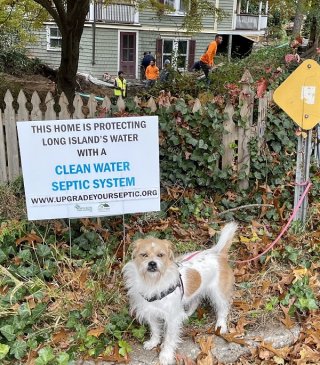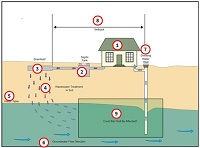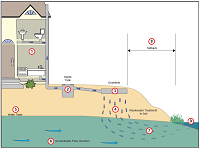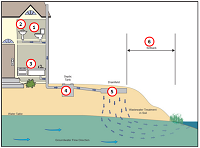Septic System Impacts on Water Sources

Septic systems may impact local drinking water wells or surface water bodies. The extent of this impact depends on how well your septic system is designed, installed, maintained and if it is used properly. Systems that are sited in densities that exceed the treatment capacity of regional soils and systems that are poorly designed, installed, operated or maintained can cause problems.
The most serious documented problems involve contamination of surface waters and ground water with disease-causing pathogens and nitrates. Other problems include excessive nitrogen discharges to sensitive coastal waters and phosphorus pollution of inland surface waters, which increases algal growth and lowers dissolved oxygen levels. Contamination of important shellfish beds and swimming beaches by pathogens is a concern in some coastal regions. healthy.
The diagrams below show more about how septic systems interact with drinking water wells or surface water bodies, including how to keep these water sources healthy. Click on the links to learn more about how septic systems interact with drinking water wells or surface water bodies and how to keep them healthy.
Protect Your Drinking Water Well
Septic systems provide wastewater treatment for many homeowners who also often get their drinking water from private wells. If a septic system is not working properly or is located too close to a drinking water well, contaminants from the wastewater can end up in drinking water. Learn how to locate, operate, and maintain your septic system to protect nearby wells.
Septic Systems and Drinking Water

Protect Your Local Surface Water
Many homeowners rely on septic systems for safe and effective treatment of their wastewater. Household wastewater is treated by a septic system before it filters into the soil. Recycled water from a septic system can help replenish groundwater supplies; however, if the system is not working properly, it can contaminate nearby waterbodies. Learn how nutrients and pathogens from your septic system may impact streams, lakes, or other waterbodies near your home.
Septic Systems and Surface Water

As a homeowner, there are several steps you can take to prevent your home’s septic system from impacting nearby water sources. Some are simple while others can be more involved and expensive. Consult with a professional in your area before making significant upgrades to your septic system.
Septic System Improvements to Protect Nearby Water Sources

Frequent Questions on Septic System Impacts on Water Quality
- Do septic systems impact water quality?
- In general, a properly installed, sited and maintained septic system should not adversely affect water quality. In some cases, the design may require advanced treatment to reduce the wastewater strength, impacts of nitrogen contamination, or include disinfection when there are properties in close proximity to surface waters.
- If the system is failing or is an older system that is discharging directly into the groundwater, the wastewater is not treated to reduce pathogens or nutrient levels. If this discharge is in close proximity to a water body, it may negatively impact water quality.
- Examples of these impacts may include:
- Groundwater contamination with pathogens, chemicals or nutrients that affect drinking water wells.
- Surface waters can be contaminated with pathogens, such as E. coli, chemicals, and nutrients including nitrogen and phosphorus.
- Pathogens can cause illnesses for recreational swimming areas, even requiring beach closures and hazards to humans and pets. Excess nitrogen and/or phosphorus can cause an overgrowth of blue-green algae or cyanobacteria in a short period of time, triggering algae blooms. The overgrowth of algae consumes oxygen and blocks sunlight from underwater plants. When the algae eventually die, the oxygen in the water is consumed. This can cause fish and other aquatic organisms to die and create regional “dead zones.”
- Coastal waters are more sensitive to nitrogen contamination from failing septic systems.
- Freshwater rivers, lakes, and ponds are more sensitive to phosphorus contamination from failing septic systems.
- The cumulative impact of failing septic systems that are in close proximity to each other and to a water body in environmentally sensitive areas may need to be addressed at the regional or watershed level.
- For more information and outreach tools, EPA's Nutrient Pollution Outreach and Education Materials offers various tools and publications to develop effective communications materials related to nutrient pollution.
- Can failing septic systems affect human health?
- A failing septic system likely discharges untreated wastewater, which contains pathogens (e.g., E. coli), nutrients and other harmful substances directly into the groundwater or onto the ground and into surface waters.
- Surfacing untreated wastewater from a failed drainfield is a direct public health hazard to anyone exposed to it. Children and pets can unknowingly be exposed to this hazard which can cause illness. If you or others have been exposed to untreated wastewater, contact your health professional.
- Straight pipes can discharge untreated wastewater directly into ditches, streams and other water bodies causing a direct public health hazard and also a regional public health hazard to anyone who comes into contact with the untreated wastewater.
- Drinking water from groundwater wells and from surface water sources can be contaminated by untreated wastewater and require filtration and disinfection to remain potable. Check with your local health department about having your water tested.
- Excess nitrogen contamination in surface or groundwater supplies can impact drinking water systems requiring special treatment.
- Chemicals that may be discharged into septic systems can negatively impact water quality and public health in both groundwater and surface water sources, even in very small amounts.
- EPA’s Quick Tip Video explains how regular water quality testing can protect and safeguard your family’s health, “Keep It Clean!”
